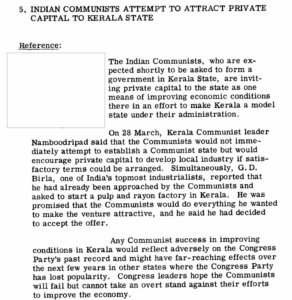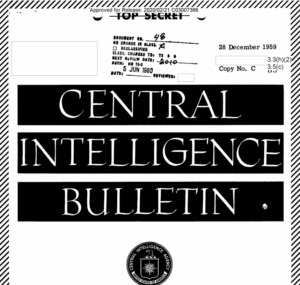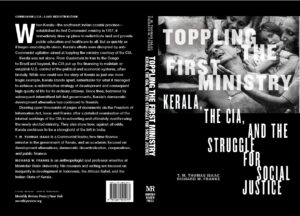A month after the dismissal, in August 1959, CPI general secretary Ajoy Ghosh alleged that the dismissal of Kerala’s first Communist government was the result of a high-level conspiracy involving the Congress government at the Centre and industrialists. However, he did not accuse any foreign powers.
Published Mar 15, 2025 | 5:02 PM ⚊ Updated Mar 15, 2025 | 5:02 PM

EMS taking oath as the first Chief Minister of Kerala
Synopsis: Former Finance Minister TM Thomas Isaac and US academic Richard W. Franke’s book, “Toppling the First Ministry,” is expected to shed light on the CIA’s covert operation, along with its local allies, to overthrow India’s first democratically elected government led by EMS Namboodiripad in Kerala.
A new experiment began in Kerala on 5 April 1957 when India’s first democratically elected Communist government under EMS Namboodiripad was sworn in.
This unprecedented political shift was hailed globally as a socio-political miracle.
However, the administration’s tenure was abruptly curtailed after 28 months, succumbing to the mass protests of the Vimochana Samaram (Liberation Struggle), leading to its dismissal by Prime Minister Jawaharlal Nehru on 31 July 1959.
For decades, whispers of the US Central Intelligence Agency’s (CIA) covert involvement in the government’s downfall have persisted, often highlighted in Communist narratives.
Now, 66 years later, these speculations are reignited, propelled into the public discourse by revelations in a to-be-published book, which claims to establish concretely ‘the internal workings of the CIA and its local Kerala allies in subverting and ultimately overthrowing the newly elected ministry.’
In 1957, Kerala made history by electing India’s first Communist government through democratic means. Led by EMS Namboodiripad, the Communist Party of India (CPI) implemented radical reforms, including labour laws, agrarian policies, and a landmark Education Act.

The first Kerala Ministry
However, these changes sparked fierce opposition, culminating in the ‘Liberation Struggle’ of 1958—one of the most intense political movements in Kerala’s history.
The agitation was spearheaded by the Church, with active support from the Congress, the Praja Socialist Party, the Muslim League, and the Revolutionary Socialist Party, according to KC John, author of Kerala Rashtreeyam Oru Asambandha Nadakam (Kerala Politics: An Absurd Drama).
The Church went as far as forming armed volunteer groups, dubbed Christopher’s Regiment, to “defend” its interests.

Bulletin dated 31 March 1957.
Meanwhile, Congress leader Panampilly Govinda Menon coined the term (as he claimed) ‘Vimochana Samaram‘ (Liberation Struggle), branding the Communist rule as a threat to democracy.
Mannathu Padmanabhan, the founder of Nair Service Society for the upliftment of Nair community, led massive protests, culminating in a memorandum to Governor B Ramakrishna Rao, demanding the government’s dismissal.
Satyagrahas, picketing, and violent clashes erupted across the state.
The book, Kerala Rashtreeyam Oru Asambandha Nadakam, stated that despite a last-minute plea from the Congress high command to limit protests to symbolic demonstrations, state leaders ignored the directive, choosing to escalate the agitation.
The movement gained national attention, and by 1959, Prime Minister Nehru—bowing to pressure—dismissed the EMS government by invoking Article 356 of the Constitution.
The ‘Liberation Struggle’ not only marked the first instance of a democratically elected government being toppled through protests but also cemented Kerala’s reputation as a battleground of intense ideological conflicts.
Ajoy Ghosh, then General Secretary of the Communist Party of India, in an article on August 1959 asked, “Why did this happen? Why was the Kerala government dismissed? Why did its dismissal evoke such protests?”
He further added, “No answer can be found to these questions if one studies the Presidential Proclamation of July 31 alone. That Proclamation merely stated that the President is ‘satisfied that a situation has arisen in which the government of that state (Kerala) cannot be carried on in accordance with the provisions of the Constitution of India. ’ No charge was levelled against the Kerala government, not a word was said as to how the Kerala government had violated the provisions of the Constitution or what the ‘situation’ was and who created it.”
A month after the dismissal, in August 1959, Ajoy Ghosh alleged that the dismissal of Kerala’s first Communist government was the result of a high-level conspiracy involving the Congress government at the Centre and industrialists.

This bulletin predicted that the anti-Communist parties together seem capable of defeating the Communists by a
substantial margin in the election to take place in February 1960. After the elections, a Ministry with Pattom A Thanu Pillai as the Chief Minister was formed, giving rise to the first coalition experiment in Kerala, consisting of the Praja Socialist Party, the Congress and the Muslim League.
However, his accusations did not extend to foreign powers, unlike as claimed later by some Communist leaders.
Ghosh argued that the EMS Namboodiripad-led government faced relentless opposition, especially over its land reform policies.
“At no time during its existence was the government given any respite,” he noted, stating that reactionary forces seized every grievance to hinder its functioning.
The opposition, he alleged, found backing from Congress leaders at the national level, including then-party president UN Dhebar and Union Finance Minister Morarji Desai.
Big business interests reportedly viewed a Communist-led state government as a deterrent to securing American aid.
Ghosh cited a statement by then US Secretary of State John Foster Dulles, who called local Communist victories in India and Indonesia a “dangerous trend.”
Around the same time, India’s then-Finance Minister TT Krishnamachari reportedly reassured the US that the Centre was battling Communism and admitted that Congress had “lost” Kerala partly due to inadequate development spending.
According to Ghosh, Congress leaders feared that allowing the Communist government to complete its term would lead to similar victories elsewhere.
This, he suggested, prompted the Centre to dismiss Kerala’s government in July 1959—a move that remains a pivotal event in India’s political history.
It was the declassified CIA and National Security Council (NSC) documents, in the 2000s, that reignited discussions about the US interference in Kerala’s politics during the late 1950s.

Bulletin on the first Communist government.
The documents suggest that the US played a covert role in destabilising India’s first elected communist government, led by the CPI in Kerala.
When the CPI assumed power in 1957, Washington saw it as a potential threat.
A May 1957 NSC briefing noted that if Kerala’s communist government succeeded in governance, it could inspire similar movements across India.
The US administration feared that economic progress under the CPI would make communism more acceptable nationwide.
Since the Indian government could not legally remove the CPI without a law-and-order crisis, the US allegedly worked behind the scenes to create political unrest.
Reports indicate that the CIA funneled money to the Congress Party and opposition groups to organize protests and strikes.
Ellsworth Bunker, then US ambassador to India, reportedly collaborated with Indian intelligence and passed funds to Nehru’s Agriculture Minister, SK Patil, to fuel agitation against the CPI.
Historian Paul McGarr’s book The Cold War in South Asia further supports these claims, stating that President Dwight David Eisenhower authorized a CIA covert operation to undermine the CPI administration.
By funding local Congress leaders and labor unions, the agency promoted strikes and political turmoil.
Amidst growing unrest, the Indian government dismissed the CPI government in July 1959.
Interestingly, in the Central Intelligence Bulletin dated 14 July 1959, it has been mentioned that in a 3 July 1959 message from the USSR to the CPI, the former “advised” the latter “not to adopt a drastic programme of violent tactics throughout India in retaliation for pressures on the Communist government of Kerala State.
The bulletin further added, “Moscow is said to have promised to support Indian Communists in undertaking “widespread agitation” instead—presumably non-violent. The Soviet directive, which appears credible given current CPI statements and Moscow’s recent efforts to avoid offending Nehru, strengthens the hand of the “moderate” CPI leaders.”
Former Finance Minister and CPI(M) leader TM Thomas Isaac’s book, , Toppling the First Ministry: Kerala, the CIA, and the Struggle for Social Justice, co-authored with American academic Richard W. Franke, is expected to be a gamechanger, revealing the covert CIA operation in India, and especially Kerala.

The cover of the book, Toppling the First Ministry: Kerala, the CIA, and the Struggle for Social Justice.
Drawing from thousands of newly declassified CIA documents obtained through the Freedom of Information Act, Issac said the 304-page book meticulously unravels how the US intelligence agency, with the help of local allies, orchestrated the downfall of Kerala’s first Communist government.
Isaac, in a social media post, confirmed that the book is fully ready, including the index, but awaits printing—publishers have set a June release, while online platforms list it for 5 July 2025.
Interestingly, Richard W. Franke was once labeled a “CIA agent” by the VS Achuthanandan faction of CPI(M) in the 2000s.
Now, the book promises to flip that narrative on its head, revealing the deep intrigues of Cold War geopolitics and Kerala’s historic struggle for social justice.
(Edited by Majnu Babu).
